How do chickens clean themselves? This is a common question among new chicken keepers. Owning chickens is anything but boring, and chicken bathing adds to the quirkiness of their personalities. Let’s take a closer look at how these funny birds take a bath.
- How To Make A DIY Dust Bath
- Dust Bath Ingredients
- Dust Bath Recipe
- Preening
- Sunbathing
- How To Bathe A Chicken
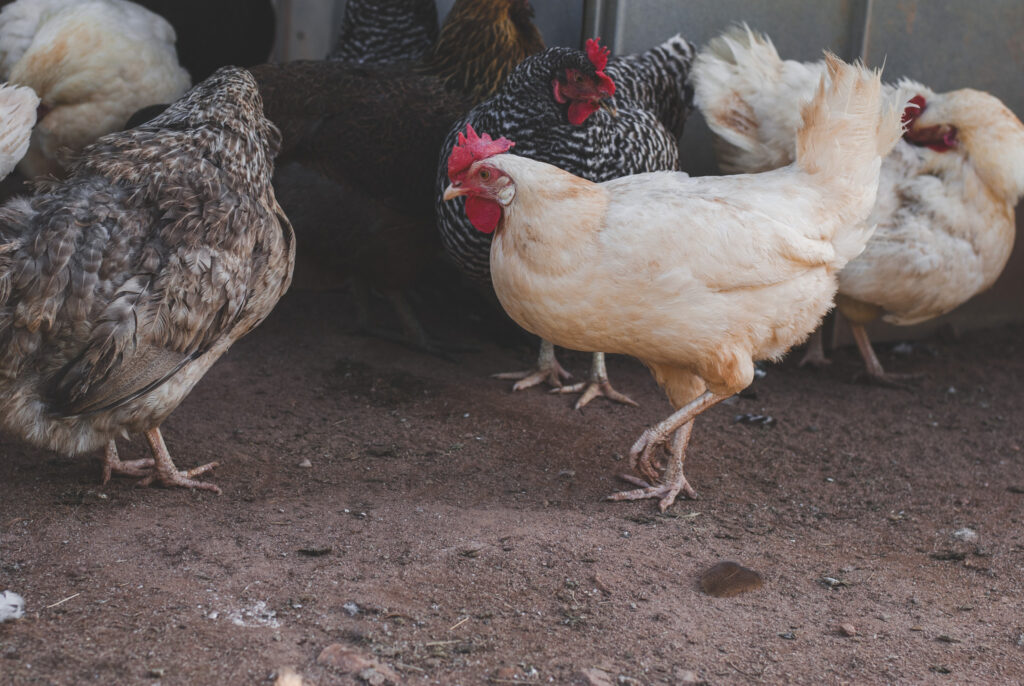
**This post may contain affiliate links which means I make a small commission at no extra cost to you. Read my full disclosure here.*
Backyard chickens clean themselves in two primary ways: dust bathing and preening. These behaviors can be baffling to first time chicken owners. However, they’re perfectly normal, and oftentimes social behaviors. Take a closer look at how chickens clean themselves and what you can do to assist them with their natural processes.
Dust Bathing
Dust bathing is just one step in the process that chickens use to clean themselves. It also has a lot of health benefits. You may have noticed your birds lying on the ground and flipping around in the dirt.
Even though they look like they’re injured, they’re just taking a bath. Dust bathing is the chicken’s way to remove and prevent unwanted parasites and mites.
They like to find an area with loose soil and scratch out a small hole. After the area is ready, they’ll roll their bodies in the hole and cover themselves with the dirt.
The abrasive properties of the sand help to remove any poultry mites, external parasites, fleas, and excess oil as well as preventing further parasite problems.
They also enjoy doing this with their friends as a relaxing social activity. You’ll usually find several chickens dusting together in the same area.
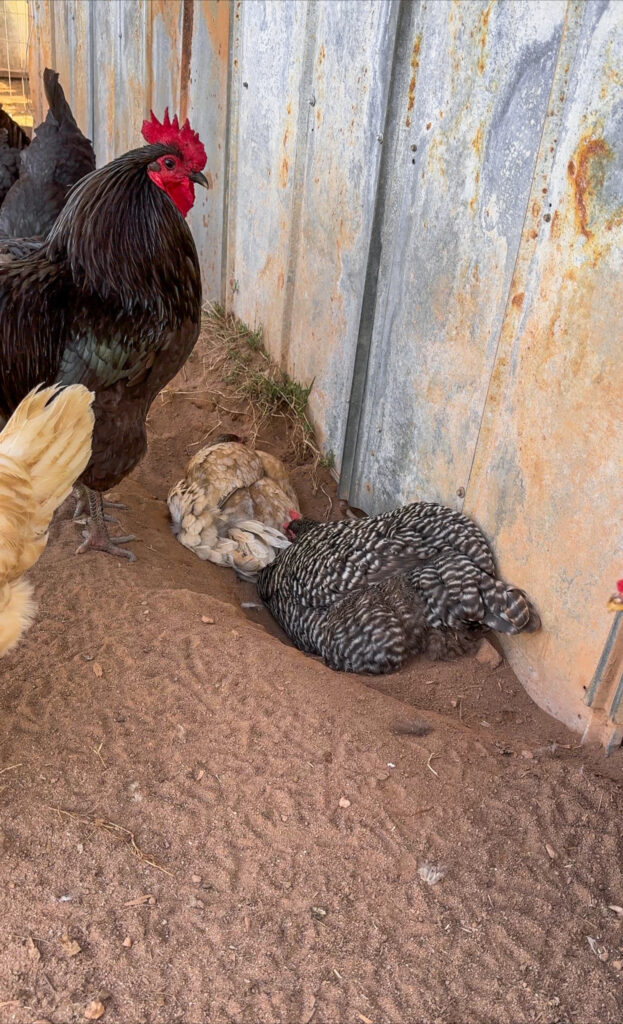
How to Make A DIY Dust Bath
You can create a dust bath by combining sand and dirt with wood ash, diatomaceous earth, and optional herbs together in a small hole in the ground or a shallow container.
Free-range chickens will generally find their own area to create and take regular dust baths. My free range flock will rarely use the nice area I made for them and choose to create their own dust bath instead.
However, if your chickens primarily live in an enclosed area, you should provide a space for them to dust bathe. Be sure to check out my post on the chicken coop size you’ll need for the number of chickens you plan to own.
A great place to create your dust bath is in the chicken run. I use old tires to hold a dust bath area for my chickens, but there are many other options you can use like a sand box or kiddie pool.
A nice hole dug out in the ground is also a great dust bath. Be sure to put your dust bath in a sunny spot. Your flock will appreciate that.
Dust Bath Ingredients
Dust baths are primarily made up of dirt, fine sand, and other loose materials.
The dust should be soft enough for them to burrow into. A hard clay soil wouldn’t work well for this. The dust or loose dirt is a carrier for the other parts of the dust bath.
Sand is probably the most important part of a dust bath. The abrasive properties help to remove excess oil and prevent mites and external parasites.
Other materials you might consider adding to a dust bath are wood ash, food grade diatomaceous earth, and various herbs.
Wood ash is a great addition but should be from a clean burned wood like fireplace ash. You could also use charcoal wood ash that hasn’t had an accelerant on it. The wood ash has antimicrobial and antiparasitic properties as well as high levels of magnesium, vitamin K, and calcium. It’s a great addition to your dust bath.
Diatomaceous earth (DE) is made from fossilized algae. They are rough and can cut the the bodies of poultry mites and other external parasites killing them. DE is a great additive to any dust bath as a further preventative measure. The bonus is it’s also great around the coop and garden in general.
Just be careful when dealing with DE. It can irritate your lungs and cause breathing problems. Wearing a mask is a good idea when dealing with it.
You may also want to add some herbs to your chicken dust bath. Herbs like rosemary, lavender, and mint have natural insecticide properties. They’re beneficial for the chicken’s respiratory system. Not to mention they also smell nice.
Dust Bath Recipe
- Begin by digging a small hole in the ground or adding the dirt bath to a shallow container like an old tire or galvanized pan.
- Add equal parts sand and dirt to the bath. The exact amount will depend on the area you are making the bath.
- Add ½ parts of wood ash and diatomaceous earth. For example, if you added a bucket of sand and a bucket of dirt, you would add ½ bucket of wood ash and ½ bucket of DE.
- Sprinkle in the optional herbs. Mix the bath ingredients well.
If don’t want to make your own dust bath, you can buy a pre-made mix of ingredients that’s ready to go.
How To Get Your Chickens To Use A Dust Bath
Have you created a dust bath, but your chickens still insist on digging holes all over their yard? Entice the chickens to use the dust bath by putting it in a spot that they can easily get to and enjoy being. For example, your flock will most likely enjoy being out in their run during the day. Your dust bath will be more enticing if it’s out in the chicken run.
Chickens enjoy dust bathing in a sunny spot. Putting your dust bath in a spot that gets plenty of sunshine will make it very inviting for the chickens.
Be sure to keep the dust bath filled with fresh loose dirt. Chickens will not want to use a dust bath filled with hard clay soil. Keep it inviting by replenishing it frequently.
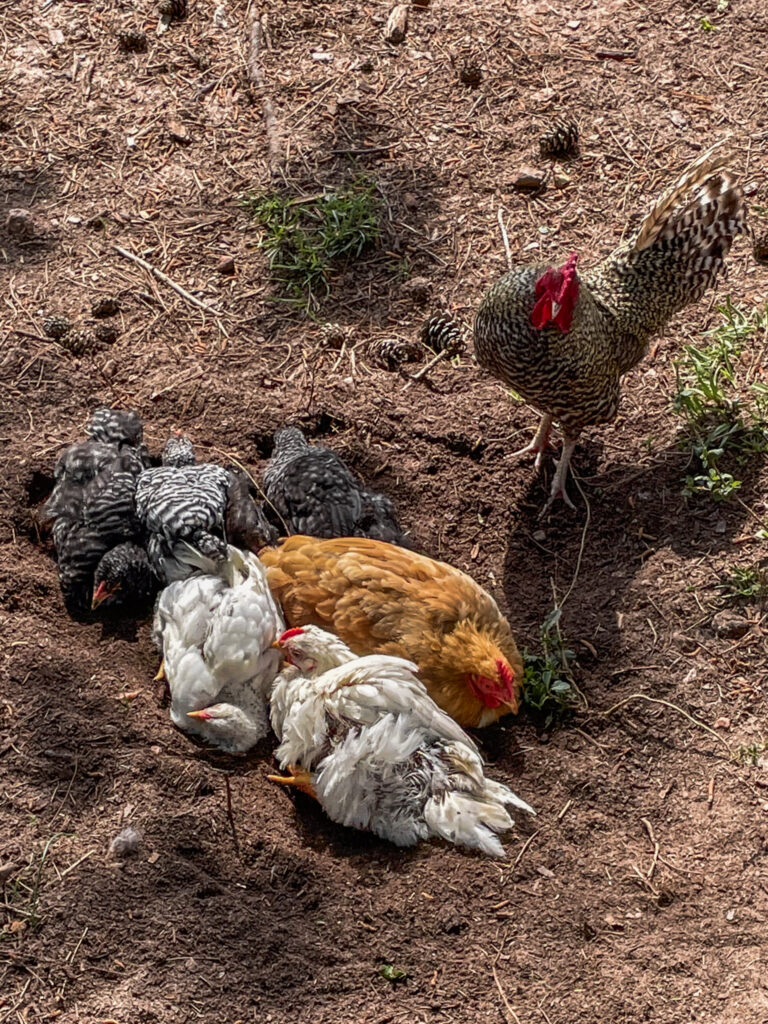
Preening
What is preening and why do chickens do this?
Preening is a natural behavior the chicken does to help protect its feathers and prevent external parasites.
The chicken has a Uropygial gland, or oil gland located at the base of their tail. This oil is crucial to protect the chicken’s feathers from water as well as conditioning.
A wet chicken will easily lose body heat. That’s why you see them avoid rain showers even in the summer. The oil creates a waterproof barrier protecting the feathers.
The oil also has antimicrobial properties further protecting the chicken from external parasites.
What does preening look like?
You might notice your bird with its head back toward the base of the tail feathers. Once your chicken locates the oil gland, it uses the feathers on its head to collect it. The chicken then spreads the oil all over the rest of its body using its head feathers like a brush.
Your chicken will also separate its feathers using its beak and then evenly distribute the oil. They really like to preen at the end of a dust bath.
Think of this as your bird’s way of fixing her hair and smoothing things out. The oil gives your flock’s feathers a smooth, glossy finish and prevents the build-up of excess moisture.
Problems with the Uropygial gland and treatment
Occasionally the small oil gland at the base of the tail can become inflamed. The cause of this can be several things ranging from injuries and disease to a lack of vitamin A in your flock’s diet.
There are a few signs you should look for if you’re concerned about an inflamed Uropygial gland:
- Frequent preening
- Enlarged gland
- Bleeding or injury around the gland
- Loss of feathers
If your bird is experiencing problems with the Uropygial gland there are a couple of things you can do to help.
- Remove the bird from the rest of the flock and into an isolated spot.
- Try using a warm compress over the gland.
- Gently press on the gland to try to relieve and impaction
- If there is a wound on the gland clean and treat the wound using items in your chicken wound first aid kit.
- If you think your bird has an infected oil gland, always consult a veterinarian who specializes in poultry.
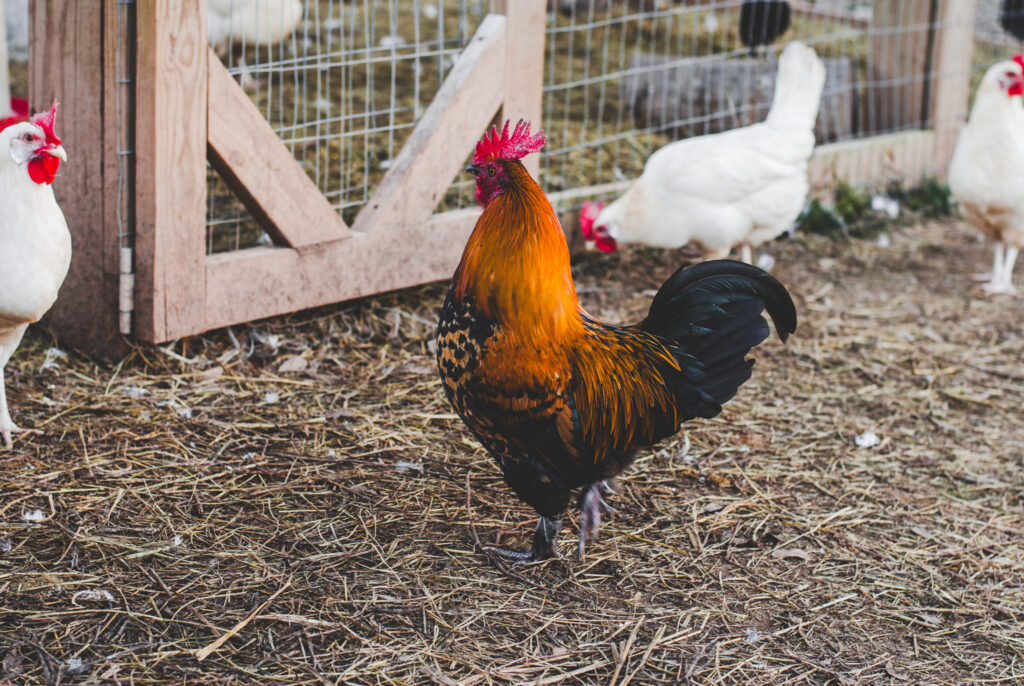
Sunbathing Benefits for Chickens
You may notice your flock lying around in a sunny spot with their wings spread. While this may appear to be just a good place to nap, sunbathing has a lot of benefits when it comes to keeping the chicken clean.
After the chickens preen their bodies are covered in a natural oil. The oil will produce vitamin D when it’s exposed to the sun. Vitamin D helps the chicken to absorb more nutrients. Better nutrient absorption will help the chicken be more healthy and produce better eggs.
Sunbathing also has antimicrobial benefits for the chicken. Many microbes are killed by direct sunlight, so sunbathing helps the chicken maintain overall health.
Be sure to provide all chickens with a sunny spot to sunbathe.
Should I Bathe my chicken?
Generally, you should not have to bathe your chicken. They do a great job of keeping themselves clean through dust bathing and preening. Bathing the chicken will remove the natural oils on its body. However, there are times when you may need to help your bird get clean.
If your has vent gleet you’ll need to soak the hen in a warm, Epsom salt bath.
If your bird has a build-up of poop around her vent. I’ve experienced this with some of my Cochins because they have such thick feathers.
Your bird may have been pooped on by a bird on a higher roosting spot.
If your bird is experiencing a flystrike. This is where a fly lays its eggs on the chicken and the maggots begin eating the skin.
If your bird has a wound that needs to be thoroughly cleaned.
How to Bathe A Chicken
- Bathe your chicken by placing it in lukewarm water and removing any dirt or debris. Make sure the water isn’t too hot or too cold.
- Your bird should not be completely submerged in the water. Just enough to cover the vent is great. Also, the chicken may not like the water at first but they will usually calm down and relax once they’re in.
- You can use a mild hypoallergenic shampoo like pet shampoo or baby shampoo. Gently massage the shampoo into the bird’s feathers.
- Be sure to rinse the chicken completely. Don’t leave any soapy residue on her.
- Dry your bird with a towel to remove any excess moisture.
- Keep her in a warm place until she is completely dry.
- A soak in an Epsom salt bath is also beneficial for conditions like being egg bound. Never leave a chicken unattended in water or they could drown.
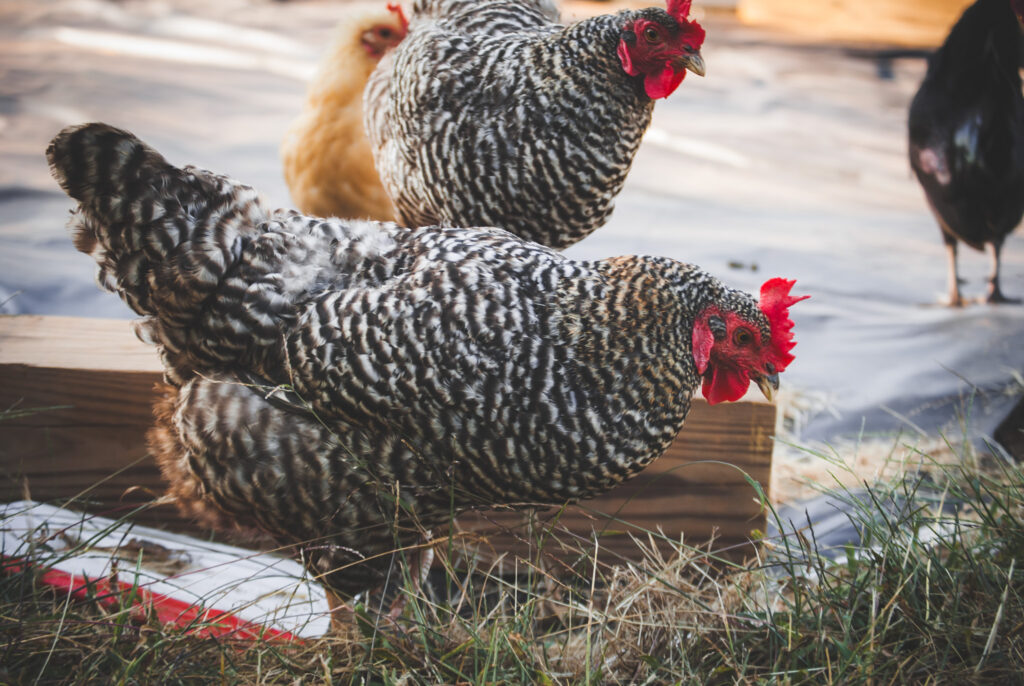
FAQs
Where should I place a dust bath for my chickens to clean themselves?
Put your dust bath in a dry, sheltered area within the chicken coop or run. Make sure the chickens can easily get to it while still being protected from the rain.
How often do chickens take dust baths?
Chickens typically take dust baths daily or every few days, depending on whether or not they have access to bathing spots.
What should I do if my chickens don’t have access to a dust bath?
If chickens don’t have natural access to dust, you should provide a dust-bathing area so they can clean themselves.
Final Thoughts
Dust bathing is important for chickens to clean themselves. This natural behavior helps prevent parasites and is great for social interactions. A good dust bath followed by preening will help your bird have healthy smooth feathers and skin. Providing an environment where your birds can have these natural behaviors will help your flock stay healthy and happy!
If you enjoyed this article, please share it! Thanks for visiting my farm!

Want to know how long unwashed eggs last on the counter vs. in the fridge? Are you confused about how to properly wash farm-fresh eggs? Check out my FREE egg care eBook!
[…] How Do Chickens Clean Themselves? […]